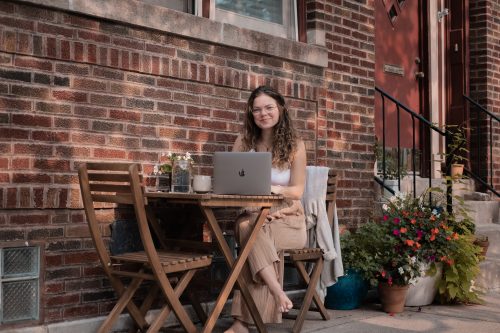A Stoop Story
By Aly Rumel
Early in the pandemic, about the same time that the snow melted off the trees in May, I simultaneously realized there would be no “return to office” in 2020, I bought an $80 bistro set on the internet: A wooden table and two chairs.

Photo Credit Nicole Nagy
I had been taking my laptop and my coffee out to the front steps in the mornings, working remotely from my “stoop office” any chance I got. After three months of quarantine, I was like a withering house plant, desperate for sunlight, fresh air, and any reminder that there was life outside the walls of my little two-bedroom apartment.
The bistro set, a welcome upgrade from the cement steps I’d been sitting on, was a bit of a long shot considering I had no actual outdoor space for it except for the (very public) sidewalk in front of my first-floor apartment. But I would do anything for the chance to reclaim even the tiniest daily connection with nature, with people, or with anything that wasn’t my own mental chatter.

Photo Credit Nicole Nagy
My parents said it would be stolen in a week. “Not locking it up? Not bringing it in at night? You’re too trusting,” they said. “This is Chicago, not the suburbs!”
I suppose we could have brought the table inside each night. Maybe it was lazy, maybe it was naïve, or maybe it was just blind optimism amidst the uncertainty of a global pandemic. In any case, my roommate and I decided we’d leave the table outside.
In one way, my parents were right.
This is Chicago.
My particular piece of Chicago is a tiny strip of historic walk-ups in Old Town, just magical enough to make you wonder if you really are still in the city, after all.
Flanked on either side by sacred spaces, a Buddhist temple to the north and a Catholic church to the south, the street itself hums with a cozy conviction, a warm and humble reverence.

Photo Credit Nicole Nagy
Time-honored neighbors like Twin Anchors and Marge’s Still make you feel like you’re somehow part of the legacy of this neighborhood, even if, like me, you’re just the latest twentysomething renting on the block, a fleeting guest to the homeowners who have lived in this secret sliver of Old Town for decades.
Before the pandemic, or rather, before the stoop, I sometimes felt lonely from this sense of transience in such an established, deep-rooted community. I envied the neighbors who called out to each other by name and stopped to check in on one another’s families, pets, and projects. At twenty-six, I had lived in a different apartment every year for the last eight years.
My pre-pandemic, pre-stoop lifestyle was nonstop. I loved my Old Town apartment and neighborhood, but I treated it more like home base than home. I blitzed around the city at lightning speed, flitting between work, social events, travel, and everything in between, returning to my home base only to briefly recharge before I dashed off to do it all again. My nonstop schedule created a constant flurry in the snow globe of my life, shaking things up so perpetually, I realized later, that I never even knew what it looked like when the snow settled.
When the pandemic hit, the flurry stopped. I was forced to let the snow float down, finally, to stillness. By no choice of my own, my life was, at last, settling around me, and my only option was surrender.

Photo Credit Nicole Nagy
Those first few nights after purchasing the bistro set, I would peer anxiously out the window each morning as I opened the blinds, holding my breath until I saw the wooden table, solid and solitary there on the sidewalk. I’d smile to myself, silently cheering that our little stoop survived another night. After the first week, we decided the table just might make it after all.
I was out there morning, noon, and night – always with a beverage (coffee or wine, depending on the hour) and more often than not with a plate of snacks. I pet every dog that passed by, and I came to recognize the human owners by their dog’s names: Sophie’s mom, Dakota’s dad, Duncan’s parents, Finn & Rosie’s family, Frankie’s mom.

Photo Credit Nicole Nagy
The more time I spent out on the stoop, the more I learned about the neighborhood and the people in it. I learned that the real reason our potted plants were thriving was that my sweet neighbor Brita watered them every morning when she watered her own window boxes. I learned that Nancy across the street liked fancy lattes as much as I did. I learned that Allen was an author, Carla was a nurse, and Kevin ran an e-commerce business. I learned that Don rode his bike to our street on Wednesdays and helped out around the block. I learned that Kelly and Abe were expecting, and Susie’s boys were home for the summer.

Photo Credit Nicole Nagy
On the weekends, especially early in the pandemic when the city was still completely shut down, my roommate and I made extravagant breakfasts (pancakes, bacon, homemade chocolate croissants…) just for the two of us and ate them in our pajamas out on the stoop. I bought a bucket of chalk and we doodled on the sidewalk all morning, popping inside every so often to refill our coffee and mimosas when they ran low. The little boys next door still talk about the elaborate chalk mosaic we made that summer.

Photo Credit Nicole Nagy
Sometimes, we’d drag out a few extra kitchen chairs from inside and crowd around the little bistro table with friends or family, each with a cold beer or glass of wine. We were all still quarantining and didn’t feel comfortable having people inside the apartment, so the stoop gave us a safe space to spend time with loved ones. It felt almost normal.
When it got chilly in the fall, I bundled up on the stoop in my grandparents’ old wool Pendleton blanket, the one I used to wear on the porch up at their cottage. Sitting on the stoop one crisp morning, bundled in my blanket with a steaming cup of coffee, I looked up and realized that the tree in front of our apartment was the prettiest on the block. It was the very first to change color in September, and if I looked straight up, I saw only golden leaves against the bright blue sky.

Photo Credit Nicole Nagy
Finally, when it started to snow, I begrudgingly folded up the set and stacked it in the back stairwell for safe keeping over the winter. I bought a real desk and worked from my bedroom for a few long and gray months. I saw neighbors occasionally, when we dug our cars out of the snow or if we crossed paths on a walk, but for the most part it was a solitary winter. I’d often find myself alone in the apartment listening for the smooth song of church bells, a reminder that the neighborhood was still out there – even if we were all burrowed inside for a few months. (As I write this now from my kitchen table, the church bells just chimed.)
As she often likes to do, Chicago teased us with a few fake springs before finally warming up enough to bring out the stoop table in good faith. In March, somewhere near the one-year mark since the world had shut down, I dusted it off and lugged it back out to its home on the stoop.
Unfolding the stoop table that second spring was like opening back up into myself, into my community. I sat out on the stoop, my coffee, laptop and I all reassuming our usual positions, and in some ways, it was like I had never left. In other ways, though, it felt like I was experiencing my community for the first time. I called out to each neighbor by name, greeting them after the long, solitary winter. When they stopped at my stoop table, we smiled and caught up with one another, checking in on each other’s families, pets, and projects.

Photo Credit Nicole Nagy
I finally understood what it meant to really be part of the neighborhood. Nancy invited me to dinner. Shel offered to promote my cookie business. Kevin swept the leaves off our stoop and Susie brought over homemade sourdough. Don stopped by one day just to say he appreciated my friendship. The boys next door knocked on the window and played peek-a-boo with me all afternoon long. Kelly and Abe walked by with their beautiful baby girl, now almost one. I started babysitting for the sweet family on the corner. Brita continued to water our thriving flowers.
At the start of the pandemic, I think I feared what I would find when all the snow settled in my snow globe life. Who would I be if I wasn’t keeping busy every minute of every day?

Photo Credit Nicole Nagy
The stoop was a soft place for me to land and bear witness as the pieces of my life slowed to a complete stop around me. It offered a space to be still, and in my stillness, I found a connection with myself and my neighborhood. I smiled in sweet disbelief every time these people, these friends, and neighbors who were strangers less than a year ago, went out of their way to be truly thoughtful. Each little thing felt like a small reminder from the Universe about the sweet depth of connection that’s possible when you finally stop the swirl and simply let yourself settle.
Even today, when I feel myself being swept back into the bustle of daily life as the city reopens, the stoop is a place where I feel rooted. I listen to the church bells and smile at the neighbors on this sweet strip of Old Town, where the pace is just a little slower, the sun just a little brighter, and the people look out for you as one of their own.

Photo Credit Nicole Nagy
It turns out that’s what a community is, after all: a place where, when all the dust settles and you show up as your most vulnerable self, you belong. I’m so grateful to my stoop, for giving me space to simply show up, and to my Chicago neighbors, for meeting me here.

















